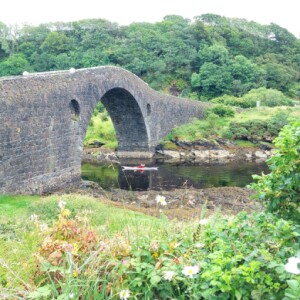This huge hole is all that remains of a deep slate quarry at Ellenabeich on the island of Seil in Argyll. The quarries were part of the extensive quarries on many of the nearby islands that employed hundreds of men in dangerous conditions. The slates were used to roof Glasgow Cathedral and other prominent buildings in Scotland and exported as far as Nova Scotia, Australia and New Zealand.
However, disaster struck in 1881. In the early morning of 22 November a severe gale from the south-westwind and an exceptionally high tide flooded the quarries on Easdale and at Eilean-a-beithich "a large rocky buttress which supported a sea wall gave way under the excessive pressure of water". The main quarry on the south side went deeper and deeper into the ground as the men chisseled out the slate. Gunpowder was then used for blasting and by 1880 the pit was 75m deep, nearly 250 feet below sea-level, with only narrow walls of slate keeping the sea out. In November 1881 the inevitable happened. There was a violent storm and the sea broke through. Luckily it was night and the pit was unmanned but 240 families lost their only means of support and severe poverty ensued. The place where this happened is still clearly visible.
Eilean-a-beithich was never re-opened although production did continue at Easdale, Luing and Balvicar. Changes in demand - clay tiles were rapidly replacing slate as the roofing material of choice - led to commercial production ceasing by 1911 on Seil and in 1914 on Belnahua. Balvicar quarry re-opened from the late 1940s until the early 1960s but slate is no longer mined anywhere in the Slate Islands.
To road to Ellenabeich and Easdale crosses the humped backed Clachan Bridge known as ‘The Bridge over the Atlantic’ because it connects the island with the mainland. It was built in 1792 with an arch about 12 metres (39 ft) above the bed of the channel, to allow the passage of boats of up to 40 tonnes at high tide. The tide was fairly low when some canoeists were paddling under. The sides of the bridge had to raised to stop sheep from jumping over.

Comments
Sign in or get an account to comment.


